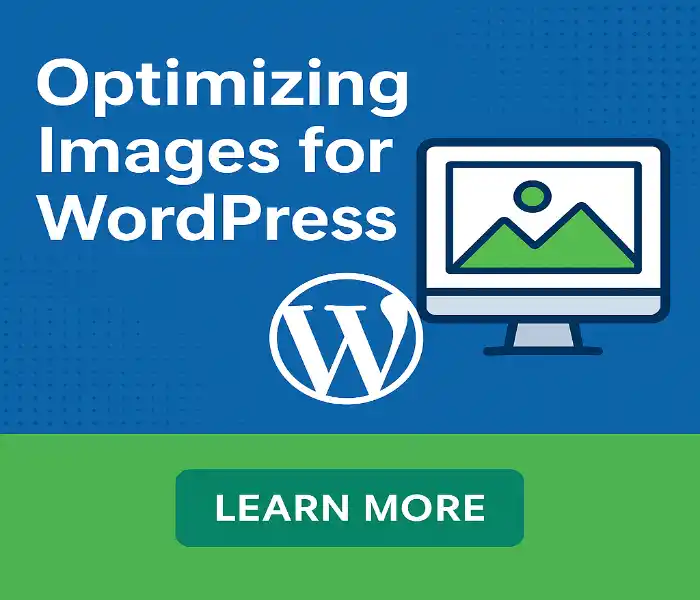Optimizing images for WordPress is the fastest way to speed up your site and stop losing visitors to slow loading times.
Your WordPress site loads like it’s running on a potato.
I get it.
I’ve fixed this exact problem for over 300 WordPress sites.
And every single time, the biggest culprit is images.
Those massive photos you uploaded straight from your phone?
They’re killing your site speed.
Your bounce rate is higher than a kangaroo on steroids.
Why Your WordPress Images Are Destroying Your Rankings
Here’s what’s happening right now on your site:
Your homepage has 15 images.
Each one is 2MB.
That’s 30MB of images alone.
No wonder it takes 8 seconds to load.
Google’s algorithm sees this and thinks: “This site doesn’t care about user experience.”
Down go your rankings.
I worked with an e-commerce client last month.
Their product pages had 12-second load times.
After implementing proper WordPress image optimization, we got it down to 2.3 seconds.
Their organic traffic increased by 47% in six weeks.
That’s real money.
The Hidden Costs You’re Not Seeing
- Slow sites lose 53% of mobile visitors (Google data)
- Poor Core Web Vitals directly impact search rankings
- High bandwidth costs from oversized images
- Lower conversion rates because people don’t wait
- Mobile users bounce faster than desktop users
Modern Image Formats That Will Save Your Site
Forget JPEG and PNG.
It’s 2025.
We have better options.
WebP: Your New Best Friend
WebP browser compatibility hit 96% globally.
That means almost everyone can see WebP images.
The file sizes are 30-50% smaller than JPEG.
Same quality.
Half the bandwidth.
It’s a no-brainer.
AVIF: The Future That’s Already Here
AVIF adoption strategies matter now.
Browser support is at 89%.
The compression is mental – sometimes 60% smaller than JPEG.
But you still need fallbacks for older browsers.
My Format Decision Process
For photos: AVIF first, WebP fallback, JPEG last resort
For logos: SVG if possible, WebP otherwise
For graphics: WebP or PNG (depending on transparency needs)
WordPress Image Optimization Plugins That Don’t Waste Your Time
I’ve tested them all.
Here are the ones that actually work:
Smush Pro (For Beginners)
Pros:
- Simple setup
- Good compression
- Free version available
Cons:
- Slow on large sites
- Limited customisation
ShortPixel (My Go-To Choice)
This is what I use for 90% of client sites.
Why it’s brilliant:
- AI-powered image optimization that actually works
- Multiple compression levels
- Excellent bulk processing
- Great AVIF support
The downside: Costs money (but worth every penny)
Optimole (For Advanced Users)
Perfect for headless WordPress setups.
Real-time optimization.
CDN included.
Works brilliantly with WordPress REST API.
Technical Stuff That Actually Matters
Let me show you the bits that make the biggest difference.
Responsive Image Implementation
WordPress has built-in responsive images.
But most people mess it up.
Here’s what I do:
<img src="image-800w.webp" srcset="image-400w.webp 400w, image-800w.webp 800w, image-1200w.webp 1200w" sizes="(max-width: 768px) 100vw, 50vw">Mobile users get mobile-sized images.
Desktop users get desktop-sized images.
Simple.
Lazy Loading That Works
WordPress now includes native lazy loading images.
But I enhance it with intersection observer API.
Why?
Because you control exactly when images load.
I set mine to load 100px before entering the viewport.
Perfect balance of speed and user experience.
Critical Image Preloading
Your hero image should never be lazy loaded.
I always preload the most important above-the-fold images:
<link rel="preload" as="image" href="hero.webp" type="image/webp">This tells the browser: “Load this immediately. It’s important.”
Mobile Image Optimization (Where Most People Fail)
Mobile-first indexing means Google judges your site on mobile performance.
Yet most WordPress sites serve desktop images to mobile users.
That’s madness.
My Mobile Optimization Checklist
✓ Serve smaller images to mobile
- Use proper srcset breakpoints
- Test on real devices (not just dev tools)
✓ Optimize for slow connections
- Test on 3G networks
- Use Chrome’s network throttling
✓ Prevent layout shifts
- Always specify width and height
- Use aspect-ratio CSS property
Breakpoints I Actually Use
- 320px: Small phones
- 768px: Tablets
- 1024px: Small desktops
- 1440px: Large screens
Each breakpoint gets appropriately sized images.
No mobile user should download a 2000px image.
Ever.
Core Web Vitals: The Metrics That Matter
LCP optimization (Largest Contentful Paint) is crucial.
Here’s my process:
1. Find your LCP element Use Chrome DevTools Performance tab.
2. Optimize that specific image
- Smallest possible file size
- Implement preloading
- Use WebP or AVIF format
3. Prevent CLS (Cumulative Layout Shift) Always specify image dimensions:
<img src="image.webp" width="800" height="600" alt="Description">This stops the page jumping around as images load.
SEO Beyond Alt Text
Everyone knows alt text.
Few know the advanced stuff.
Image Schema Markup
I add structured data to important images:
{ "@context": "https://schema.org", "@type": "ImageObject", "contentUrl": "https://example.com/image.webp", "caption": "Detailed description" }Better understanding = better rankings.
Visual Search Optimization
Google Lens compatibility is huge now.
File naming: red-nike-shoes-size-10.webp not IMG_1234.jpg
Descriptive alt text: Red Nike Air Max running shoes size 10 not shoes
High-quality images: Blurry photos perform terribly in visual search
Automation: Set and Forget
Manual optimization doesn’t scale.
WordPress CLI Commands
wp media regenerate --yes wp media optimize --allI run this weekly via cron.
Performance Monitoring
Tools I actually use:
Google PageSpeed Insights – Free, shows real user data
GTmetrix – Great for before/after comparisons
WebPageTest – Advanced testing from multiple locations
Key Metrics to Watch
- LCP under 2.5 seconds
- CLS under 0.1
- Total image size per page
- Percentage of modern formats (WebP/AVIF)
Common Mistakes That Kill Performance
1. Optimising Small Images First
Wrong approach.
Start with your largest images.
That 2MB hero image matters more than 50 tiny icons.
2. Over-Compressing Product Photos
File size matters.
But not at the expense of sales.
Your product images need to look good.
3. Ignoring CDN Setup
Perfect images still load slowly without a CDN.
Use Cloudflare, AWS CloudFront, or similar.
4. Not Testing Real Conditions
Your fiber connection doesn’t represent your users.
Test on 3G mobile regularly.
Advanced Implementation: Service Workers
For sites that need to fly, I implement service worker image caching.
self.addEventListener('fetch', event => { if (event.request.destination === 'image') { event.respondWith( caches.open('images-v1').then(cache => { return cache.match(event.request) || fetch(event.request); }) ); } });Images load instantly on repeat visits.
Perfect for Progressive Web App optimization.
WordPress Multisite Considerations
Running multiple sites?
WordPress multisite optimization needs centralised management:
- Shared media library
- Single CDN configuration
- Bulk optimization across network
Frequently Asked Questions
Q: Should I use WebP or AVIF? Use both. AVIF first with WebP fallback. Browser support varies.
Q: How much compression is too much? Test different levels. For product photos, don’t go below 80% quality.
Q: Do I need a CDN for a small site? Yes. Even free Cloudflare makes a massive difference.
Q: Can I automate everything? Most of it. Use plugins for compression, CLI for bulk operations.
Q: What about existing images? Run bulk optimization. Most plugins handle this automatically.
Q: How often should I optimize? New uploads get optimized automatically. Audit existing images quarterly.
Q: Does image optimization affect SEO? Absolutely. Page speed is a ranking factor. Faster sites rank better.
The Bottom Line
WordPress image optimization isn’t optional anymore.
It’s essential.
Your competitors are doing it.
Google rewards fast sites.
Users expect instant loading.
Start with your largest images first.
Implement WebP with fallbacks.
Use lazy loading properly.
Monitor your Core Web Vitals.
And remember – a 1-second delay in page load time costs 7% in conversions.
That’s money walking out the door.
Fix your images.
Fix your business.
The tools and techniques in this guide will transform your WordPress site performance, improve your search rankings, and ultimately optimize images for WordPress in a way that actually moves the needle for your business.




